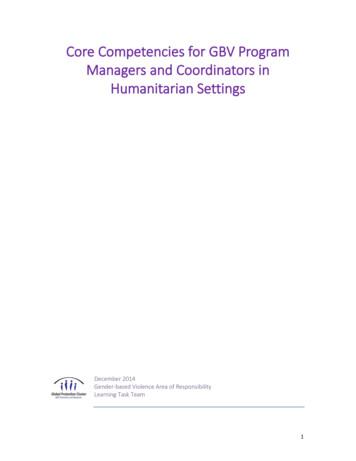Macro Programming With Script - GBV
CATIA V5MacroProgramming withVisual Basic ScriptDieter R. ZiethenTranslatedby KyleE. BrandMcGrawHillNew YorkLisbonChicagoLondonMilanSeoulSan FranciscoMadridMexicoNew DelhiSingapore SydneyCitySan JuanToronto
ContentsPrefacexvii1Basics1.1Definition of1.2Definition of Nomenclature1.3Definition of Object, Class, and1.3.11.3.2Object and ClassObject Path41.3.3Root Class and Base Classes51.4Basic61.5Selecting1.6Storage of a Macro1.6.11.6.21.7Starting1.7.11CATScript and CATVBSExampleofa13Object Path44MacroMacro Editora89StorageinaCATIA Document10StorageinaSeparate File10aMacro fromaButton1112a Macro to a Button1.7.2AssigningCreating a Toolbar1.7.3Assigning1.8Blocks of a Macro1.8.1Head of1.8.2Declaration of Global Variables and Objects161.8.3CATMain, Subroutines, and Functions171.9Branches and1.9.1If-Then-Else1.9.2Select-Case-ElseaaButton to12aToolbar141415Macro19Loops,1920
viIContents1.9.3For-Next211.9.4Do-While211.9.5Do Until221.10Anchor Objects of CATScript23CATIA-Application231.10.11.10.2 CATIA Documents "CATPart" and "CATProduct"1.10.3Geometry Containers2425in CATParts1.10.4 Structural Information and Metadata261.11Using the Macro Recorder281.12Additional Information292Communicating2.1Screen Output and ate, Load, and Save CATIA Documents2.2.12.2.2with the Environment313435DocumentsCreatingLoading Documents3637Documents2.2.3Saving2.3User Selection of CATIA Elements382.3.1Selection beforeStarting a392.3.2Selectionduringthe Execution olor and Hide Elements442.5.1Coloring Elements442.5.2Hiding2.6Reading and Writing2.6.1Create2.6.2Reading Data2.6.3Writing2.7Executing External Programs and CATScripts482.7.1External Program492.7.2External sElementsorDeclare404145DataaFileDataEnvironment Variables4646474850
3Components of CATParts3.1Attributes3.1.1Standard Attributes543.1.2Custom metrical Sets3.3.3Ordered Geometrical3.3.4Boolean3.4Parameters and s683.5References693.5.1References3.5.2References to3.5.35353Elements55GeometricalSets,and Ordered Geometrical Sets555658Operations59Setsbetween BodiesTable6166Geometry7070References toObjectsObject Names3.5.4Referencesthe Name of the3.6Direction Definition743.6.1Direction Dennedbya753.6.2Direction Definedbyan4Components of CATProducts4.1Attributes774.2Parameters and Formulas784.3Assembly Structure4.3.1AnalyzingAdding Elements4.3.2totoan70Boundary RepresentationVectorObject71757778Existing Structure7879ReplacingDeleting Elements804.4Constraints8152D Wireframe5.1Sketch References and Sketch5.2Creating Sketch Geometry4.3.34.3.4Elements80GeometryObjects838385
TiiiIContents5.3DefiningConstruction Elements and the Rotation Axis885.4CreatingConstraints8963D Wireframe6.1General Procedure6.2Points6.2.1Methods for6.2.2Case Studies: PointsGeometry and Surfaces919193Creating Points6.3Lines6.3.1Methods for6.3.2Case Studies: Lines939596Creating Lines97996.4Planes6.4.1Methods for6.4.2Case Studies: Planes6.5Curves6.5.1Methods for Creating Curves1066.5.2Case Studies: Curves1096.6Surfaces6.6.1Methods for6.6.2Case Studies: Surfaces6.7Transformations6.7.1Methods for6.7.2Case Studies: Transformations6.8Operations6.8.1Methods for Creating Operations1196.8.2Case Studies:1217Solids7.1General Procedure7.2Sketch-Based Solids7.2.1Methods for7.2.2Case Studies: Sketch-Based Solids7.3Surface-Based Solids7.3.1Methods reating112113115Creating g Sketch-Based SolidsCreating126127129Surface-Based SolidsStudies: Surface-Based Solids129130
7.4Transformation-Based Solids7.4.1Methods for7.4.2Case Studies: Transformation-Based Solids7.5Operations7.5.1Methods Based Solids133135137Creating Operations onStudies: lipse2D178
peCurvePar237
8.105HybridShapePlanel Curve3278.106HybridShapePlanel 18HybridShapePointCenter337
098.161OrderedGeometricalSet410
edShape4718.204Sketches471xiii
3VBScript Commands497497
5129.52MsgBox5129.53Now5129.54Null5129.55On Error Resume ct Case515xv
5189.76Trim5199.77UCase5199.78Year519Index521
Contents Preface xvii 1 Basics 1 1.1 Definition of CATScriptandCATVBS 1 1.2 Definition of Nomenclature 3 1.3 Definition of Object, Class, andObjectPath 4 1.3.1 ObjectandClass 4 1.3.2 ObjectPath 4 1.3.3 RootClassandBaseClasses 5 1.4 Basic Exampleof a Macro 6 1.5 Selecting aMacroEditor 8 1.6 Storage ofaMacro 9 1.6.1 Storagein aCATIADocu
GBV. Increase public awareness of GBV by moving away from the mere 16 days of activism to a robust 365 days campaign against GBV and encourage every citizen to take specific steps to prevent GBV in both the private and public arena. In light of the recommendations made the Government UN GBV JP facilitated a one day workshop
script. Fig. 1 shows examples of the same TCC characters in all five major styles. Figure 1. Standard script, clerical script, seal script, cursive script, and semi-cursive script (From left to right) The standard script is used in daily life. The clerical script is similar to stan
macro language processor and defines the SAS macro language elements. This section introduces the SAS macro facility using simple examples and explanation. The macro facility is a tool for extending and customizing SAS and for reducing the amount of text you must enter to do common tasks. The macro facility enables you to
Excel, Outlook, PowerPoint, and Access. Macros are blocks of VBA code that perform specific tasks. When you Record a Macro, Word will write VBA code into a Macro, allowing you to repeat your actions. You can see a list of all available Macros from View Macros. After recording a Macro, you will be able to edit the Macro from the Macro List:
1 Hands-On SAS Macro Programming Essentials for New Users Kirk Paul Lafler, Software Intelligence Corporation, Spring Valley, California Abstract The SAS Macro Language is a powerful tool for extending the capabilities of the SAS System. This hands-on workshop teaches essential macro coding concepts, techniques, tips and tricks to help beginning users learn the basics of how the Macro language
Hands-On SAS Macro Programming Essentials for New Users, continued PharmaSUG 2016 4 Essential #1 - Debugging a Macro with SAS System Options The SAS System offers users a number of useful system options to help debug macro issues and problems. The results associated with using macro options are automatically displayed on the SAS Log.
managing a GBV program with an NGO or coordinating a GBV working group. GBV coordinators can and are recruited without GBV program management experience and sometimes move from coordination into program management positions. Many GBV Program Managers do not move
The Gender Based Violence (GBV) conference will bring together partners working in the GBV Sector; Government Department stakeholders; representatives from donors in the Development Sector, SANAC and the Global Fund. The conference will focus on: The State's Response in dealing with GBV Exploring the link between GBV & HIV























